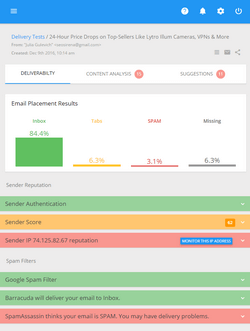How to Find the Best Time to Send an Email Newsletter
In the previous chapter we’ve already touched upon the issue of finding the best time to send email campaigns. We concluded that Tuesday, Wednesday and Thursday are generally good days to distribute email newsletters. However, the weekend days should not be disregarded either because for some businesses sending email campaigns on weekends can result in higher activity from the recipients.
Now we’d like to go deeper and try to determine how to find the best time to send (or scheduler) the email campaigns. This question is more complicated, and like everything in email marketing, depends on numerous variables and your specific situation.
When determining the best time to send your newsletter, you should remember that the email delivery process involves many factors that may be beyond your control such as
– Recipient factor
– Delivery duration
– Queue factor
– ISP factor
Let’s examine each of these factors closer.
Recipient Factor
The question you should ask yourself regarding your recipients is when they are most likely to open your email and take a desired action.
The experience shows that the majority of emails are opened throughout the day between 5 a.m. and 5 p.m. (PST) on Tuesday and Thursday. Obviously, most business related customers open emails during their workday. Consumer-oriented subscribers can open emails at any time.
Age, job, demographics, sex, and time zone factors do matter as well. If you are emailing students or teens, they are most likely to open your message when they get home from school or college. So, the late afternoon is a good time to send your message. Homemakers will most likely read the emails in the middle of the day. In addition, many people may not have access to the Internet or email due to their occupations (construction, factory and restaurant workers, doctors, nurses, teachers and many others). Then they will check their mailboxes in the evening or on the weekend.
Differences in sex could be a factor as well. Males versus females are more likely to be online during the prime evening television viewing hours.
Are your recipients from the United States or do they live all over the world? When people in New York start their workday, the European citizens prepare to go home. So, if you are in the United States and send your emails in the morning at the beginning of the workday, some of your recipients in Europe, Asia, and Australia may not catch your message the same day unless they check their mailboxes at home. If you have the subscribers all over the world, consider segmenting your mailing list according to major time zone periods – and schedule the emails to each group accordingly.
It’s important that during the sign-up process you collect as much information about the habits and preferences of your subscribers as possible. Based on those details you will be able to determine the time period (or periods) when they are most likely to open and act on your emails.
Delivery Duration
The list size does matter. It can take from a few minutes to hours for your email software or provider to actually send the emails to all the subscribers on your list. You should monitor and understand this duration period and take it into account when calculating the optimal time to send your email campaigns.
Queue Factor
If you are using an ASP solution or sharing a mail server with others in your company, keep in mind that after you click the Send button in your email client, your emails may not be sent immediately but will go “in the queue” and may take longer time to be sent than you expected. You should find out if the “queue factor” applies to you and add this estimated time into your calculations.
ISP Factor
Not all ISPs work equally. Some ISPs deliver emails immediately after they receive them. Others may take one or more hours to process emails. In addition, some ISPs use volume-based filters, so sending too many emails to within a short amount of time may cause your emails to be blocked – and sent to the ISP blackhole. If you notice that one or more ISPs consistently show a significant delay in the delivery, consider splitting those subscribers into smaller groups and scheduling them for an earlier delivery time.
Calculating the Best Sending Time
Now when you are aware of the major factors that may affect the email delivery and open times, let’s deduce a formula to calculate the optimal time to send your email newsletter:
DOT – (IF + DD + QF) = ST
Where
DOT – desired open time
IF – ISP factor
DD – delivery duration
QF – queue factor
ST – scheduler or send time
Example: 1 p.m. – (1 Hour + 1 Hour + 0.5 Hour) = 10:30 a.m.
This example shows that if you decide that the best time for your recipients to open your email is at 1 p.m., you need to schedule your email to be sent at 10:30 a.m.
If you don’t want to calculate the ideal time for your email campaign, at least you should do the following:
- If your email list is high, schedule your emails well in advance of the desired open time.
- If your list is fairly small, then perhaps an hour or so in advance might be enough.
Table of contents | Page list for this chapter | Next page

